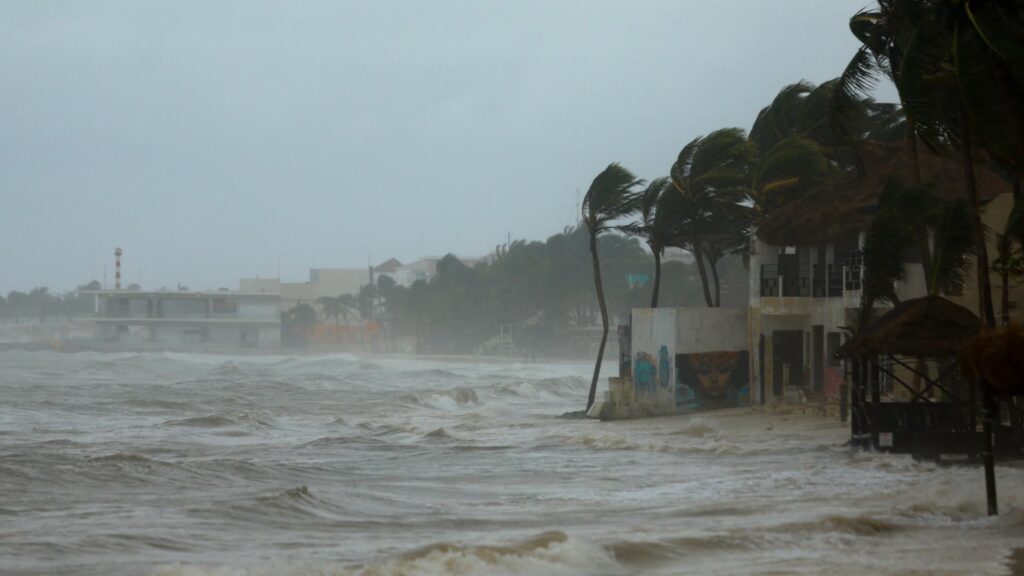Beryl entered the Gulf of Mexico on Friday, targeting the south coast of Texas after striking Mexico’s Yucatan Peninsula. Texas officials issued a disaster declaration and urged coastal residents to prepare if the storm approaches.
Beryl struck Tulum as a Category 2 hurricane, causing downed trees but no injuries, before weakening to a tropical storm as it crossed the peninsula. The National Hurricane Center expects the storm to regain hurricane strength over the warm waters of the Gulf and hit South Texas late Sunday or early Monday.
Beryl was the first Atlantic storm to develop into a Category 5 hurricane, killing at least 11 people as it moved through the Caribbean islands earlier this week.
On Friday afternoon, the center of the storm was located in the Gulf of Mexico, about 615 miles (995 kilometers) southeast of Corpus Christi, Texas. The hurricane center said it was moving west-northwest at 13 mph (about 20 km/h) with maximum sustained winds of 60 mph (95 km/h).
Forecasters said once it enters the Gulf, Beryl could regain 90 mph (150 kph) winds before reaching Texas, but it’s difficult to tell where it will make landfall. A hurricane watch is in effect north of the Rio Grande, covering most of the Texas coast.
Some Texas counties have issued voluntary evacuation orders for low-lying areas, and Texas officials urged coastal residents to prepare.
In Corpus Christi, on the Texas coast, city officials announced they were running out of sandbag supplies after distributing 10,000 sandbags in less than two hours on Friday.
“This is a determined storm and it remains strong,” Texas Lieutenant Governor Dan Patrick said at a news conference.
Patrick issued a preemptive disaster declaration for 40 counties, allowing state and local authorities to begin planning and contracting for response.
State emergency operations chief Nim Kidd said oil companies have begun moving workers away from coastal drilling rigs that may be in the path of the storm.
Northeastern Mexico and southern Texas were already inundated by Tropical Storm Alberto just weeks ago.
This week, beryl has caused havoc in Jamaica, St. Vincent and the Grenadines and Barbados. Three people died in Grenada, three in St. Vincent and the Grenadines, three in Venezuela and two in Jamaica, officials said.
Laura Velázquez, the head of Mexico’s civil protection agency, said Beryl caused no casualties and “very little damage,” but tens of thousands of people were still without power.
Tulum was plunged into darkness as the storm made landfall. The piercing winds set off car sirens across town. Wind and rain continued to batter the seaside city and surrounding areas Friday morning. Army brigades patrol the streets of tourist cities, clearing downed trees and power lines.
Lucía Nagara Balcaza, 37, started hoarding food and hiding in her home after watching Beryl cross the Caribbean.
“Thank God we woke up this morning and everything was OK,” she said. “The streets are a disaster, but we’re cleaning them up here.”
Officials had set up shelters in schools and hotels before the storm hit Mexico. As high winds whipped Tulum’s beaches on Thursday, officials on four-wheelers drove along the sand with megaphones telling people to leave, and authorities evacuated beachfront hotels. Sea turtle eggs are even being moved away from beaches threatened by storm surges.
Tourists are also taking precautions. Lara Marsters, 54, a therapist who came to Tulum from Boise, Idaho, said she has filled empty water bottles from the tap.
“We’re going to hunker down and stay safe,” she said.
While many in the Yucatan Peninsula took a deep breath, Jamaica and other hurricane-ravaged islands remained shaky. As of Friday morning, 55% of Jamaica remained without power and most areas were without running water, according to government data.
Jamaican Prime Minister Andrew Holness pledged swift relief to residents affected by Hurricane Beryl after visiting the southern parish of St. Elizabeth, one of the island’s hardest-hit areas, on Thursday afternoon.
“I know some of you are experiencing discomfort and displacement, and I want to reassure you that the government will act as quickly as possible to get you the help you need,” he said.
Earlier this week, the hurricane damaged or destroyed 95% of homes on the two islands of St. Vincent and the Grenadines, disrupted fishing boats in Barbados, ripped off roofs and knocked out power in Jamaica.
On Union Island in St. Vincent and the Grenadines, a man who called himself Captain Baga described the impact of the storm, including how he filled two 2,000-gallon (7,570-litre) rubber water tanks in preparation.
“I fastened them securely on six sides; I watched the wind lift these tanks and carry them away – full of water,” he said Thursday. “I’m a sailor and I never believed the wind could do what I saw. If anyone told me the wind could do this, I would tell them they were lying!”
The island is littered with the remains of houses that look like they exploded.

